1518. As I said, I have a short, shameful musical confession to make. It's not the following bit, though; this I am quite proud of. The shame comes later, so stay with me.
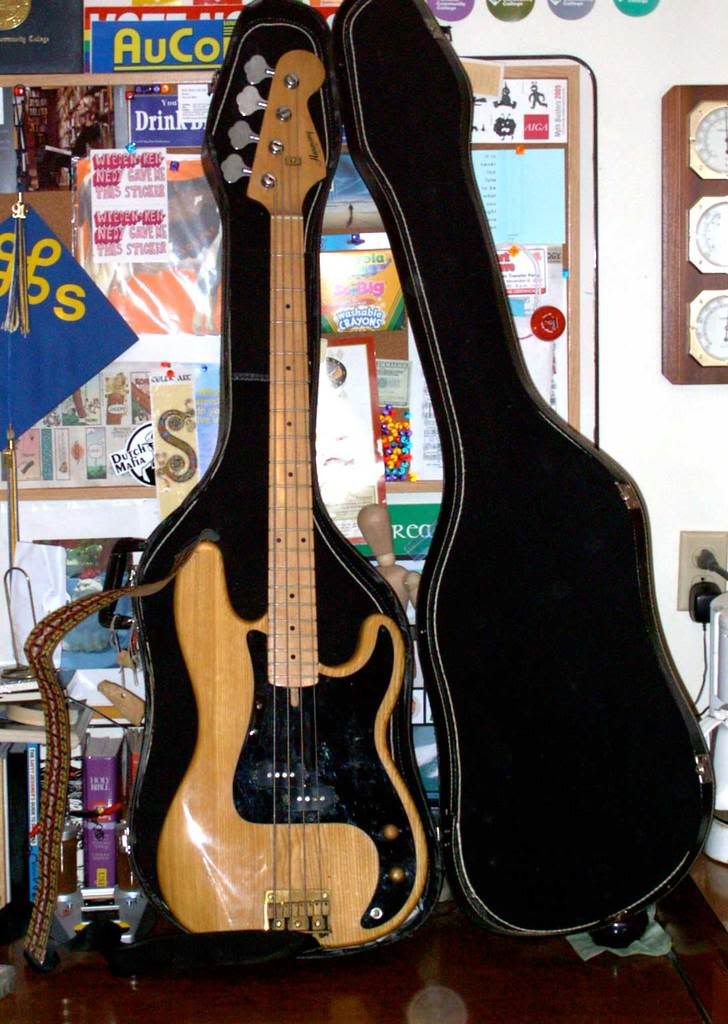 I own a bass guitar. I adore basses, everything about them; I up the bass on all my music, and of all my favorite bands, my favorite member is the bassist (for bonus points, then: Kelly Groucutt, John Entwistle, Tony Lewis, John Lodge, Pete Farndon, John Taylor – who do they play with? I don't know what you're going to do with the extra points, but they're yours ... ). I even follow the bassists in groups whose music I doesn't like.
I own a bass guitar. I adore basses, everything about them; I up the bass on all my music, and of all my favorite bands, my favorite member is the bassist (for bonus points, then: Kelly Groucutt, John Entwistle, Tony Lewis, John Lodge, Pete Farndon, John Taylor – who do they play with? I don't know what you're going to do with the extra points, but they're yours ... ). I even follow the bassists in groups whose music I doesn't like.
Some years back, in hopes of joining that number (even if only as a hobbyist) I got a bass of my own. It's a beautiful little blond-wood "P-Copy" (which is a bass geek's way of saying "it looka like a Fender Precision) which was apparently made by Harmony. That's her on the right.
Here's the shame part. The confession. Though I've been her keeper for many years now, I still don't know how to play her. That's right. I've promised and promised and promised myself and her we'd hook up and I've never followed through. Oh, every now and again I'd relearn how to tune her and then practice a few scales but then I'd get distracted by necessity or some bright shiny thing.
The shame grows deeper. Though I know she's a Harmony bass, I don't know what model she is. Now, I do know something about Harmony; at one time it was the biggest manufacturer of guitars in America. Most hobbyists and a great deal of pros played Harmony products. Harmony still exists, more of a niche company now, but they're still there.
But that's right; I brought her home and not only didn't get serious about playing her, I never even really got to know her very well.
The bass guitar is a beautiful thing, and I have done her a disservice by neglecting her so. To have a bass is an honor – maybe one that anyone with the proper coin can have, but an honor nonetheless – and I have not up to now been acting very deserving of the honor. I may indeed soon begin getting serious about playing her. But first I want to get to know her the way I should; I want to identify this one.
I am at this point putting out a call for help, to anyone wise the the lore of the musical instrument. Can anyone clue me into what sort of a bass I have here? Follows some closeups.
Here's the headstock:

The Harmony logo is properly done, in the proper place and attitude, and complete with the "Est. 1892" tag line. I purchased this bass in 1984, I think it was, and the original Harmony company had been relegated by the end of the '70s. Could it be possible that Harmony licensed the name out?
Here's a closeup of the body:
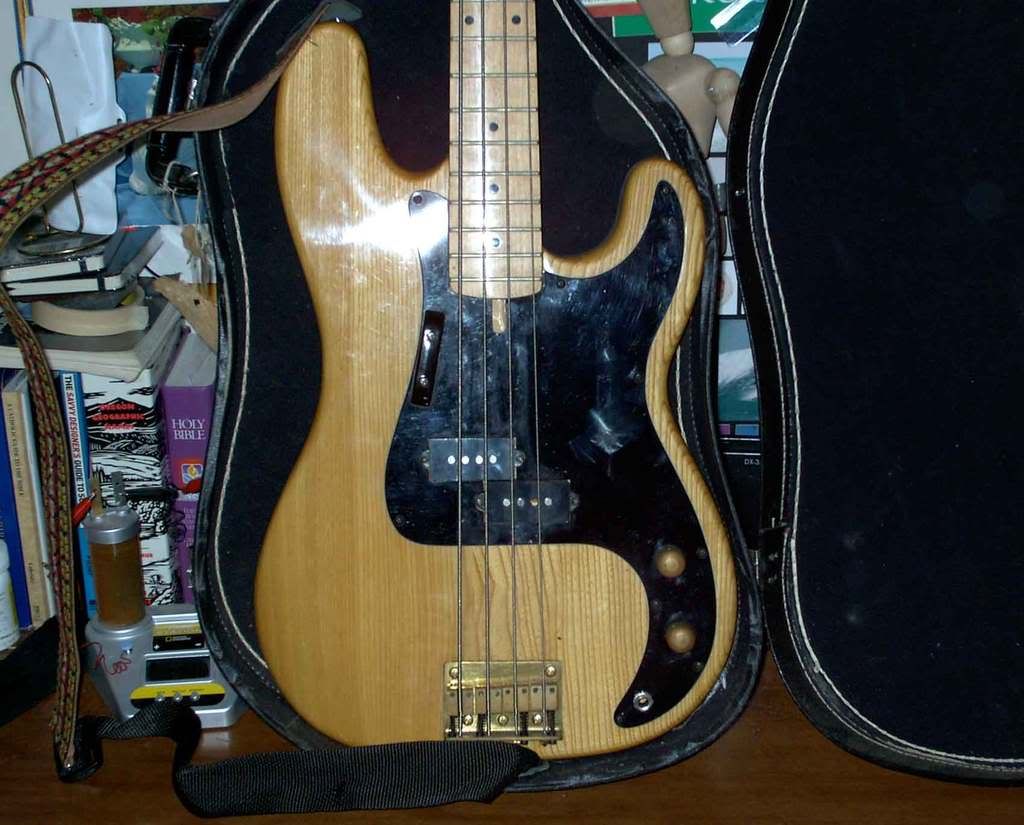
Tone and volume controls, two staggered pickups, and a thumbrest there on the left at the edge of the scratchplate. If you look carefully at the end of the fretboard there, between the A and D strings, you'll see the access too the neck tensioning nut (which I usually see in pictures on the headstock adjacent to the nut).
Here's the back of the headstock:
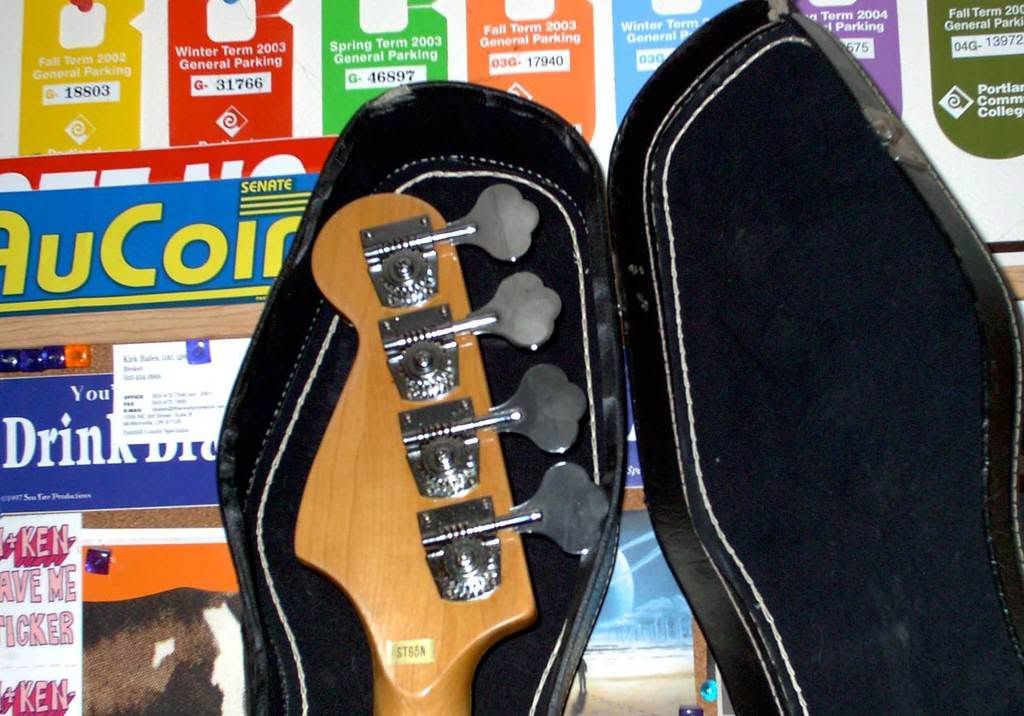
Note the little sticker there at the bottom of the headstock. Here's a closer view:
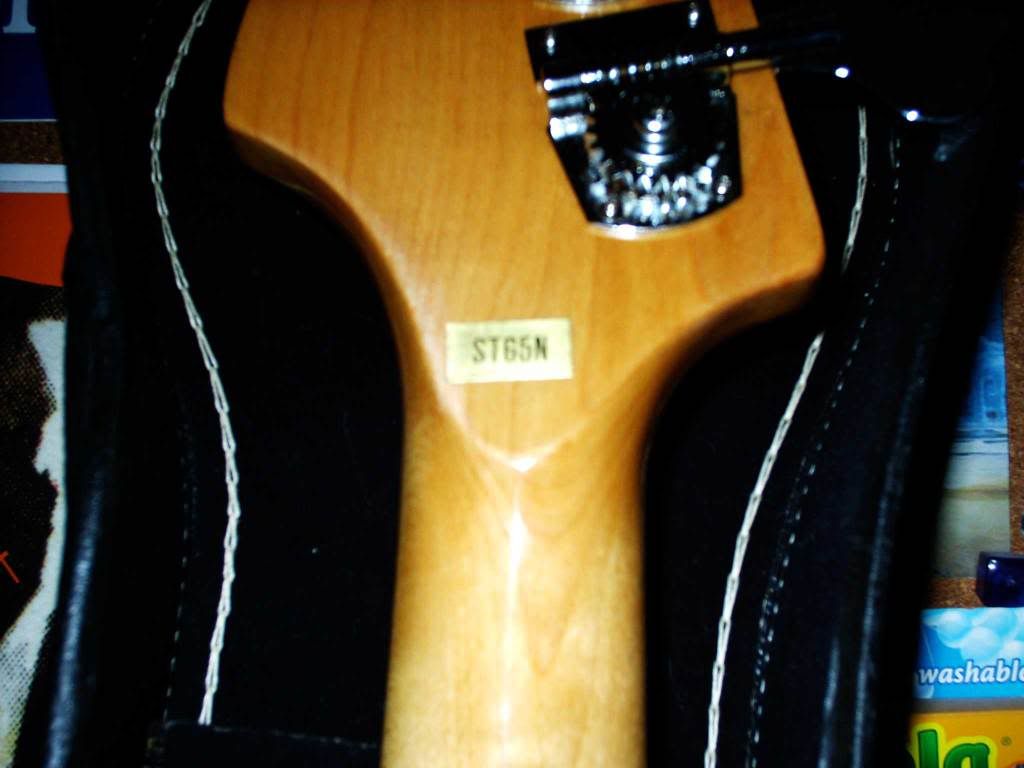
It reads "ST65N", which I think may be the model number. But I'm not sure about this; the Harmony H65 wasn't a bass. So I don't know what that sticker's supposed to be telling me.
To bring the proceedings toward their close, here's the back:
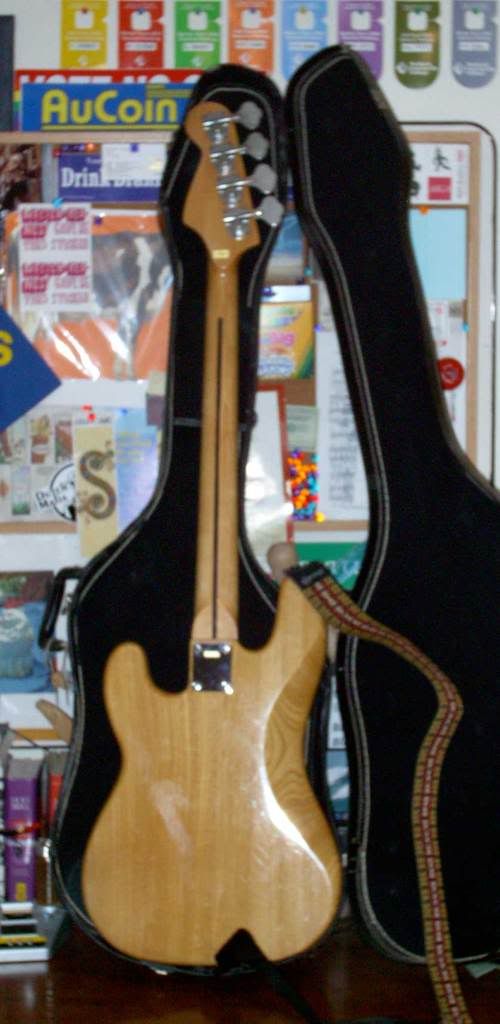
Not a great picture; somewhat blurry. Note thedark stripe down the middle of the neck; it is an inlay that no doubt closes in the neck tensioning bar. There is a metal plate there at the neck-body junction that probably houses something somehow.
That's her. If I can get her identified, then maybe I can make up for keeping her in the dark all these years. So someone help me please!
And I do intend, soon, to learn how to play her. I'm not one of those "bucket list" types; I always thought naming a list of 100 (or however many) things to do before you die just sets you up for hating yourself on your deathbed if you didn't get the whole list checked off. Better you identifiy your passions and chase them as best you can; if you go after what you want, you really can't say you've completely failed.
But if I was a "bucket list" type, playing a bass in a band on stage at least once in my life would be right up there near the top. I don't know if this is around the corner or a few years down the street yet, but, one way or the other, I'm going to do it.
Tags: dreams, music, bass guitar, Harmony guitar, Harmony bass, p-copy
Powered by Qumana

6 comments:
go to this guys page. He's the harmony guy. http://www.broadwaymusicco.com/HARMONY.htm
I have a '63 H27 bass and an archtop of some kind. The archtop has S-57-T stamped inside, which means it was made in summer or spring of '57. Unsure about the T. Serial number format changed a few times between the 40s and the 60s. But on all hollowbodies it was stamped inside and on the solids they usually stamped it at the butt of the neck, you can't see it unless you take the neck off. A serial number on a guitar needs to be permanent, so I'm guessing that yours might be stamped at the butt, rather than on a sticker that could be easily pulled off by anyone.
those don't look like original pickups, either. Your Harmony is an Asian-made one, though.
I was kind of hoping you'd chime in here. You're wise in the way of musical instruments and consequently awesome that way.
I've been doing some web surfing about Harmony guitars and the observation you made about this being an Asian-made guitar certainly is correct. I've subsequently found another sticker reading "Made in Korea". The Harmony Guy also touches on the Harmony name being licensed to Asian companies during the 70s and 80s. That's definitely what I have.
I can find a serial number nowhere on this guitar. The only identification I can find anywhere on the instrument is the logo (apparently the "Est 1892" legend is a dead giveaway about this) and the two stickers.
I suppose the serial number might be somewhere under the scratchguard or in the crevice where the neck and the body meet, but I'm not quite willing to take her apart. I'd just b0rk it.
While I'd of been thrilled to know I'd stumbled on a huge find, I'm not unhappy that it's just an Asian copy. It seems to be fairly well-made, has held up well in storage, feels and looks good, and is playable (at least by my complete tyro hands)
I do intend on at least learning the bass line to the Barney Miller theme. I understand if I don't the Bass Police will come to my house and take away my birthday, and I don't want that to happen, so I better get busy.
The Bass police haven't found me yet. I haven't learned the Barney Miller theme, or the Night Court one, or the Seinfeld one (which is a keyboard from what i hear, anyway).
Harmony instruments have always been at the very least serviceable, they do the job. They have unique tones. I've played some very cool sounding ones. My H27 has a very watery, acoustic tone to it.
At some point, if you're like me at all, the lack of knowledge about a serial number is going to eat at you and eventually you'll take it in to a shop and tell them to find it for you. lol!
I bet once you start goofing on it you'll want to play it more and more. Basses are like that :)
Ooh i just scored a new git myself.. pop on over and see what it is!
oh hey the metal plate at the neck/body junction is just sort of protecting the wood under it. You pull those four screws out and the neck comes off. That's all. Nothing else really there.
I bought one of these from Sears or Wards catalog, in the late 70's I believe, because it was almost a perfect match for my fender precision and I wanted it for a back-up. Was $140 new. It had the model name "Marquis" on the peghead in addition to the Harmony brand name. I was impressed by it's solid feel and good quality bridge and tuners. The original pickup looked exactly like yours which made it easy for me to swap in a genuine fender precision pickup! Didn't use it very much (Fender was pretty infallible) but when I did it was very close to my P-bass in feel and sound. Hope you have learned to play a few tunes by now!
Post a Comment